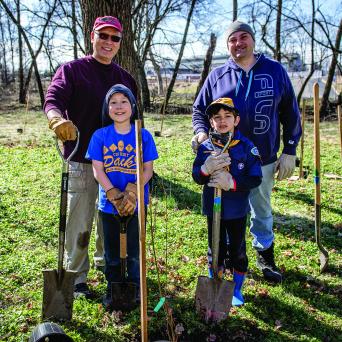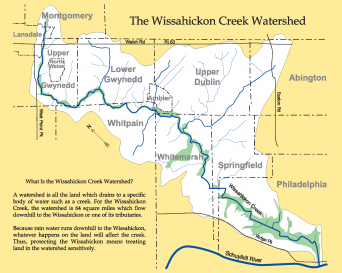Upstream, It’s the Wissahickon Valley Watershed Association
With the pending expansion to a third Co-op store in Ambler, Weavers Way will soon be serving shoppers in both Philadelphia and Montgomery counties. Another way of looking at this is through the lens of nature: The Co-op will be broadening its membership base to households living within the upper portion of the Wissahickon Creek watershed — a large area of land that drains the surrounding streams and tributaries into the creek, encompassing 64 square miles in all, or parts of 16 municipalities.
Current Co-op members are probably more familiar with the lower portion of the Wissahickon drainage, which is part of Fairmount Park and known for Forbidden Drive, Valley Green Inn and an extensive network of hiking and biking trails. This portion is under the stewardship of the nonprofit Friends of the Wissahickon, founded in 1924.
The “friend” of the Montgomery County portion is the Wissahickon Valley Watershed Association, a nonprofit conservation organization founded in 1957 to preserve and protect the natural landscape of the upper creek corridor. The mission of WVWA is to preserve open space and disappearing wildlife habitat in order to protect water quality and the natural beauty of the creek and surrounding watershed.
Over the years, the gradual replacement of woods and farmland by housing and commercial development has resulted in more stormwater runoff and flooding, causing increased pollution to the creek and its tributaries. In other words, whatever happens to the surrounding watershed affects Wissahickon Creek, which also holds for the Philadelphia portion of the creek.
Since its founding, WVWA has preserved roughly 1,400 acres of open space by acquiring undeveloped properties through conservation easements, outright acquisition or landowner donations, and actively manages these lands as a chain of natural preserves. Today, WVWA administers 11 preserves.
WVWA has also sought to preserve the riparian corridors along the creek and its tributaries. It has created the 12.6-mile Green Ribbon Trail, a continuous passive recreation trail for foot traffic only (including dogs on leashes) that follows the creek.
This trail begins near the Wissahickon headwaters in Upper Gwynedd Township, skirting Ambler as it crosses Butler Pike, and ends at Stenton Avenue in Whitemarsh Township at the Bloomfield Farm portion of Morris Arboretum, within a short walk of Forbidden Drive. It connects some of other natural preserves and parks, including Fort Washington State Park. All told, the WVWA either acquired or received permission to allow trail access over more than 40 properties and 200 acres to complete the trail. In 2014, WVWA started a Trail Stewards Program, working closely with the FOW’s Trail Ambassadors, to provide trail users with everything from the history of the creek to plant identification and proper pruning techniques.
WVWA is committed to scientific research to better understand nature and its challenges. A primary concern is excessive stormwater, the effects of which are erosion, nutrient overload and sedimentation. Essential to improving water quality is addressing the degradation at the creek’s headwaters and its nearby tributaries. More recently the association has tackled the problem of an overabundance of deer in southeastern Pennsylvania, which results in destruction of native plants from deer browse.
WVWA has also become active with environmental and outreach programs seeking to foster a deep appreciation for the natural world by engaging participants in hands-on activities.
Volunteers are always needed to staff seasonal special events, such as a Creek Watch Program of trained citizen scientists, who monitor the water quality and aquatic life. WVWA offers various education programs including ones for those interested in birding, such as bird walks, bird banding and bird biology.
Each year, WVWA and FOW co-sponsor a Creek Clean-Up, which offers a great opportunity for individuals, families and groups of all skill levels and ages to participate. This year it is scheduled for April 28.
Headquartered at Four Mills Barn and Nature Reserve on Morris Road near Ambler, WVWA recently welcomed a new executive director, Gail Farmer, who was formerly the Director of Education at the Schuylkill Center in Upper Roxborough. For more information, including membership and events, visit www.wvwa.org.
William Hengst is a Weavers Way working member.


